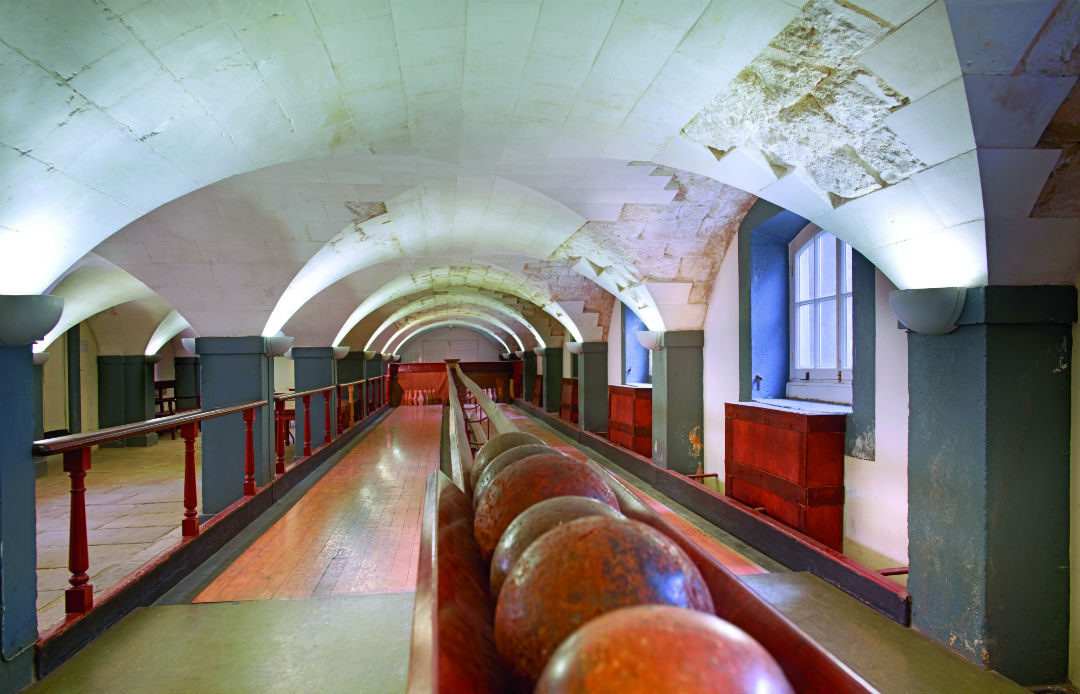
To understand the Old Royal Naval College at Greenwich the visitor must appreciate that it is not one building, but four.
A fifth, which was originally crucial to its design, stands more than 330 ft (100 m) away, beyond a bustling main road. The remains of a sixth lie embedded among the foundations of one of the main college buildings.
To add to the confusion, the best place to view the college is not within its boundaries but on the far side of the River Thames. This vantage point was used by Canaletto to produce a classic painting of the college soon after its completion in 1752.
From here, the enigma of Greenwich resolves itself into one of the glories of English architecture. The four key blocks, named after Queens Anne and Mary and Kings Charles and William, frame that fifth regal building: the Queen’s House.
The college’s origins date back to 1694 with the foundation of a Royal Hospital for Naval pensioners who, in the motto of the hospital, were ‘safe moor’d in Greenwich tier’. In 1873 the buildings became the Royal Naval College, for research and the training of officers. Today, the buildings, centrepiece of the Maritime Greenwich World Heritage Site, are occupied by Greenwich University. The government’s decision to sell the college prompted a debate in the House of Lords, during which one noble speaker insisted, ‘If there were a designation of buildings as Grade I triple star, these would qualify, both on historical and on architectural grounds.’
All of this is the work of not one architect, but many. Sir Christopher Wren takes most of the credit, planning four new buildings to respond to the much older Queen’s House, completed in 1637 by Inigo Jones. Wren laboured under three key conditions: he was to retain the shell of a palace started but not finished by Charles II; he was not to obstruct the view of the river from the Queen’s House; and the result was to be magnificent.
Wren’s skill lay in turning the problems into a solution. So Charles II’s half-built palace was absorbed into what is now the King Charles building, which is on the right, nearest the river, as one looks from Canaletto’s viewpoint. Wren designed a companion to the King Charles building, the Queen Anne building, with the Grand Square between them. Further back from the river, he produced the more ornate King William and Queen Mary buildings, each crowned by a spectacular dome.
The Queen’s House, which lies on the line dividing the four blocks, thus not only had its view of the river preserved, but became the focus of what one Wren biographer called ‘the most distinguished group of buildings in England’.
There is, however, a disparity between the grandeur of Wren’s work and the relative plainness of the Queen’s House, which makes it an unlikely, if distinguished, climax to the composition. Sir John Summerson, one of Britain’s most respected architectural historians, therefore described the domes as ‘two cats looking at each other in the absence of a king’.
Beneath those domes, the William and Mary buildings contain the college’s most celebrated interior spaces: the Painted Hall and the Chapel, respectively. The Painted Hall, the grand dining room of the original hospital, is among the contributions of yet another distinguished architect, Nicholas Hawksmoor, who served as Wren’s assistant. It was decorated, in nineteen years of stop-start labour, by Sir James Thornhill, who produced a fervent Protestant celebration of Britain’s maritime power and prosperity.
The Chapel is a calm and reflective contrast to the Painted Hall, though this is not the original interior, which was destroyed in 1779 by a fire that broke out in a tailor’s workshop below. The present chapel, of 1789, is the work of James ‘Athenian’ Stewart, one of the eighteenth century’s finest neo-classical architects.
Under the Queen Anne building, a few dozen metres away, are the remains of the sixth building: the Tudor palace of Placentia. This was the birthplace and riverside playground of Henry VIII, which fell into decay and was mostly demolished by Wren. Its crypt survives, and archaeologists have traced more of its plan beneath the Grand Square.
Almost nothing remains to reflect the lives of the thousands of sailors who lived out their days as Greenwich pensioners, though their skittle alley has survived intact beneath the King William building.
The King William block also has the unique distinction of being the only seventeenth-century building ever to house a nuclear reactor. It was home to a small training reactor used by the Royal Navy between 1962 and 1996, now dismantled.
The Navy left finally in 1998, but on Trafalgar Night, groups of men, their chests heavy with medals, may be seen strolling after dinner in the grounds of the Old Royal Naval College. The heart of the Navy remains safe moor’d at Greenwich.
Words: Mark Daly.




1 thought on “Unseen London: Old Naval College, Greenwich”